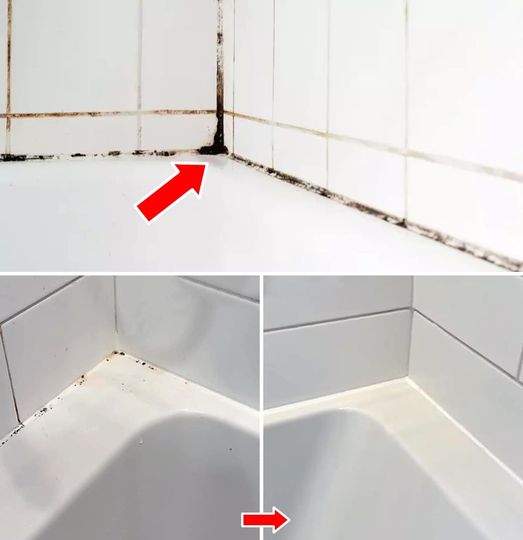ADVERTISEMENT
Sure! Here’s an engaging article based on the title “How to Remove Black Mold from the Bath Silicone in 10 Minutes”:
How to Remove Black Mold from Bath Silicone in 10 Minutes 🛁🖤
If you’ve ever noticed dark, unsightly patches on the silicone caulk around your bathtub or shower, you’re not alone. Black mold (or mildew) is a common problem in damp areas like bathrooms, and it loves to settle into the nooks and crannies of bath silicone. Not only does it look unpleasant, but it can also pose health risks, such as respiratory issues or allergic reactions. The good news? Removing black mold from bath silicone is easier than you think, and you can do it in just 10 minutes!
Here’s a simple and effective guide to banishing black mold from your bathroom silicone and restoring that fresh, clean look.
🧴 What You’ll Need:
Before you get started, gather the following supplies:
- White vinegar or hydrogen peroxide (both are natural mold killers)
- Baking soda (optional, for stubborn mold)
- Spray bottle (for vinegar or hydrogen peroxide)
- Toothbrush or scrub brush (preferably an old one)
- Gloves (to protect your hands from mold spores and cleaning chemicals)
- Rag or paper towels
- Bucket of water (to rinse off excess cleaning products)
🧽 Step-by-Step Instructions
1. Ventilate the Area 🌬️
Mold spores can be harmful to your health, so it’s important to ventilate the bathroom properly before you start cleaning. Open a window or turn on the bathroom exhaust fan to keep the air circulating and reduce exposure to mold spores.
If you’re sensitive to mold, consider wearing a mask while cleaning to protect yourself from inhaling any spores.
2. Spray Vinegar or Hydrogen Peroxide 🧴
Both white vinegar and hydrogen peroxide are excellent natural mold removers. Choose one based on what you have at hand:
- Vinegar: Fill a spray bottle with undiluted white vinegar. Vinegar’s acidity is great at breaking down mold and mildew.
- Hydrogen Peroxide: If you prefer hydrogen peroxide, fill a spray bottle with 3% hydrogen peroxide. This works wonders in killing mold, and it’s safe to use on most surfaces.
Spray the solution directly onto the affected areas of the bath silicone where the black mold is present. Make sure to soak the moldy spots generously, and allow it to sit for about 5-10 minutes to let the solution work its magic.
3. Scrub the Area 🧹
After the cleaning solution has had time to sit, grab your toothbrush or scrub brush. Use it to gently scrub the moldy silicone, working in small, circular motions to loosen the mold.
The black mold should begin to lift, and the silicone will start to look cleaner. Focus on any crevices and corners where mold is likely to settle. Be thorough, but don’t be too rough to avoid damaging the silicone.
For tough mold spots, you can create a paste using baking soda and water. Apply this paste to the moldy areas, and scrub with the toothbrush again. Baking soda is mildly abrasive, which can help scrub away stubborn mold without damaging the silicone.
4. Rinse Off the Area 🚿
Once you’ve scrubbed the silicone clean, rinse the area with warm water to remove any residue from the vinegar, hydrogen peroxide, or baking soda paste. Use a clean rag or paper towel to wipe the surface dry. It’s important to remove all cleaning solution to prevent buildup and to allow the silicone to dry thoroughly.
5. Dry the Area Completely 💨
Mold thrives in damp environments, so it’s crucial to dry the area completely after cleaning. Use a clean towel or cloth to ensure that the silicone is dry to the touch. You may also want to run the bathroom fan for a few hours to help speed up the drying process.
🔄 Tips for Preventing Black Mold in the Future
Once you’ve successfully removed black mold from your bath silicone, it’s essential to take steps to prevent it from returning. Here are some tips for keeping your bathroom mold-free:
- Keep the Bathroom Well-Ventilated: After showers or baths, leave the door or window open to allow moisture to escape. The drier the environment, the less likely mold will grow.
- Use a Mold-Resistant Silicone Sealant: When it’s time to replace old caulk, look for mold-resistant silicone. This can help prevent mold from taking hold in the future.
- Wipe Down Surfaces Regularly: After using the shower or bathtub, wipe down the silicone and surrounding surfaces to remove excess moisture.
- For Complete Cooking STEPS Please Head On Over To Next Page Or Open button (>) and don’t forget to SHARE with your Facebook friends
- Fix Leaks: Mold loves moisture, so if you have any leaks aroun
